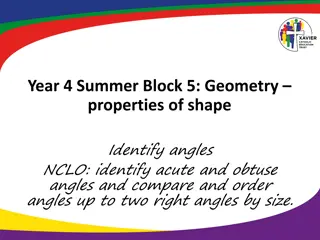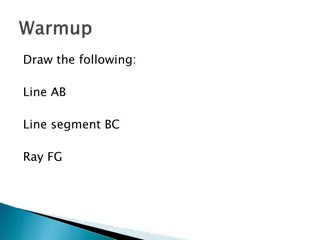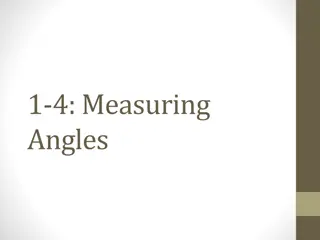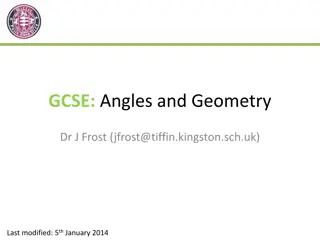Polygon Armchair | Occasional Chairs | Collective Melbourne
Buy Polygon Armchair allows you a complete custom transformation by selecting from Prostoria\u2019s wide range of fabrics, leathers & metal frame finish from Collective, Melbourne's premier luxury furniture makers. Visit Us Now!\n
1 views • 2 slides
Introduction to Geometry Tools: Circle, Line, Perpendicular, and Angles
This content introduces essential geometry tools like the circle, line, perpendicular, and angles, with details on their construction and applications. Learn about rulers, compasses, protractors, and more for drawing shapes and measuring lengths and angles. Discover how to construct circles, line se
2 views • 12 slides
Exploring Interior and Exterior Angles of Triangles
Discover the world of interior and exterior angles of triangles through engaging activities and visual aids. Learn how to calculate the angles, understand the Triangle Sum Theorem, and master the concept of remote exterior angles. Get ready to sharpen your geometry skills with practical examples and
0 views • 28 slides
Exploring Polygon Angles in Geometry
Explore the interior and exterior angle measures of polygons, understand theorems related to polygon angles, classify polygons based on their properties, and solve problems involving regular polygons in this geometry chapter slideshow. The content covers key concepts such as the sum of interior angl
1 views • 41 slides
Understanding Angles and Turns in Year 3 and 4 Mathematics
Explore the concept of angles as a measure of a turn in Year 3 and 4 mathematics. Learn to describe the direction of a turn, understand how angles are created, and identify patterns related to angles and turns. Engage in activities to practice recognizing and describing angles, as well as determinin
1 views • 20 slides
Understanding Circles: Tangents, Inscribed Angles, and Theorems
Explore the concept of circles in geometry, focusing on tangent lines, inscribed angles, and related theorems. Understand the properties of tangents, relationships between angles and arcs, and how to apply theorems in circle problems. Visual examples and explanations included.
1 views • 19 slides
Understanding and Comparing Angles in Mathematics
In this educational material, students will learn to differentiate between acute, right, and obtuse angles. They will practice identifying angles, ordering them from smallest to largest, and determining angles within various shapes. The content also includes reasoning exercises to enhance understand
1 views • 16 slides
Three-Dimensional Geometry: Direction Cosines and Angles
Understanding direction cosines and angles in three-dimensional geometry is crucial for determining the orientation of lines in space. By calculating direction cosines, we can find the angles a line makes with the positive directions of the X, Y, and Z axes. This knowledge helps in various geometric
0 views • 18 slides
Polygon Clipping Techniques and Algorithms
Polygon clipping involves modifying line-clipping procedures to achieve bounded areas after clipping. The Sutherland-Hodgman algorithm is commonly used, where polygon boundaries are processed against window edges to generate closed areas for appropriate area fill. This process involves testing for v
1 views • 17 slides
Understanding Trigonometric Ratios and Examples
Trigonometry involves studying the relationships between the angles and sides of triangles. This content covers trigonometric ratios in right-angled triangles, including sine, cosine, tangent, secant, cosecant, and cotangent. It provides examples and illustrations to help understand how to apply the
1 views • 20 slides
Understanding Exterior Angles in Polygons
This content explains the concept of exterior angles in polygons and the Exterior Angle Theorem. It covers how exterior angles are formed when the sides of a polygon are extended, their relationship with interior angles, and how to calculate their measures using the Exterior Angle Theorem. Various e
2 views • 26 slides
Exploring Interior Angles in Polygons
Investigate and calculate the sum of interior angles in polygons, explore relationships between angle measures and number of sides, and apply formulas to determine missing angles. Utilize a protractor for accurate measurements and identify patterns within the results.
6 views • 15 slides
Filling Polygons Using Scan Line Algorithm
Learn how to fill polygons using the Scan Line Algorithm, which involves intersecting scan lines with polygon edges and filling the area between intersections. Steps include finding Ymin and Ymax, intersecting scan lines with edges, sorting intersection points, and filling the interior of the polygo
0 views • 36 slides
Solving Bearings and Geometric Problems
This content discusses solving problems involving bearings, geometric shapes, and properties of triangles and lines. It covers determining bearings between points, finding angles in isosceles triangles, and understanding parallel lines and angles. The content also includes information on angles in q
0 views • 6 slides
Exploring Camera Angles in Photography
Photography is a form of art that involves various creative expressions, including the use of different camera angles to capture unique perspectives. This content explores different camera angles such as high-angle shot, low-angle shot, Dutch angle, and straight angle, each offering a distinct visua
1 views • 7 slides
Understanding Circular Motion: Co-Terminal Angles and Radian Measure
Explore the concept of co-terminal angles in circular motion, finding lengths of circular arcs, understanding linear and angular speed, and calculating radian measures. Dive into examples of finding co-terminal angles, determining arc lengths, and converting angles to radians. Discover the relations
2 views • 13 slides
Understanding Regular Polyhedra and Polygons
Regular polygons and polyhedra are fundamental shapes in geometry. A regular polygon has sides and angles that are congruent, such as equilateral triangles and squares. Polygons are simple closed figures made with line segments. Polyhedra are solids bounded by polygons as faces. Regular polyhedra ar
0 views • 18 slides
Understanding Angles in Year 5 Mathematics
In Year 5 Mathematics, students are learning about angles, including how to measure acute and obtuse angles using a protractor, calculate reflex angles, and understand concepts such as right angles, straight angles, acute angles, obtuse angles, and full turns. The lesson includes practical examples
0 views • 19 slides
Effect of Shooting Angle on Lay-Up Shoot Results in Basketball Games Study
Understanding the impact of shooting angles on lay-up shoot results in basketball games is crucial for players' performance. Researchers conducted a study to investigate the outcomes of lay-up shoots at various angles on both the right and left sides of the court. The research involved observation a
0 views • 10 slides
Mastering Line and Triangle Geometry: Rules and Angle Calculations
Revisit the main rules and terms of line and triangle geometry to calculate angles. Understand types of angles, such as right, acute, obtuse, and reflex. Learn about various angle rules like angles on a straight line, angles at a point, vertically opposite angles, angles in a triangle, equilateral t
0 views • 46 slides
Understanding Angle Relationships with Parallel Lines
Explore the concept of angle relationships created by intersecting lines and transversals. Learn about linear pairs, congruent angles, supplementary angles, alternate interior and exterior angles, corresponding angles, and more. Engage in activities, quizzes, and worksheet assignments to deepen your
0 views • 9 slides
Understanding Polygons in Geometry
Explore the concept of polygons, their sides, vertices, and angles, and learn to classify them as convex or concave. Discover the Polygon Angle Sum Theorem and find the sum of measures of angles in a given polygon.
0 views • 13 slides
Understanding Interior Angles in Polygons
Explore the concept of interior angles in polygons, including definitions of polygons, convex and concave polygons, regular and irregular polygons, as well as the sum of interior angles in triangles and quadrilaterals. Discover the naming convention for polygons based on their number of sides and le
0 views • 16 slides
Understanding Polygon Properties and Classification
Explore the fundamental concepts of polygons, such as vertices, sides, angles, and classifications like convex and concave polygons. Learn about the interior and exterior angles of polygons, the sum of angle measures, and the properties of regular polygons. Discover how to identify, classify, and ca
0 views • 13 slides
Understanding Fill Area Primitives in Computer Graphics
An overview of fill area primitives in computer graphics, including the concept of fill areas, polygon fill areas, and polygon classifications into convex and concave polygons. This module covers the efficient processing of polygons, approximating curved surfaces, and generating wire-frame views of
0 views • 63 slides
Raster Graphics and Scan Conversion in Computer Graphics
This lecture covers various topics related to raster graphics and scan conversion in computer graphics. It includes issues with scan converting a line, generalized line drawing algorithms, and the midpoint circle drawing algorithm. Additionally, it explores deriving mathematical expressions for draw
0 views • 21 slides
Exploring Properties of Shapes: Triangles and Quadrilaterals
Delve into the properties of shapes like triangles and quadrilaterals to uncover missing angles, identify types of triangles, and compare various quadrilateral shapes. Enhance your understanding of angles, opposite angles, and angles within shapes to solve geometric puzzles and problems effectively.
0 views • 37 slides
Understanding Angles and Shapes in Geometry for Year 4 Students
Explore the world of angles and shapes in geometry with a focus on identifying acute and obtuse angles, comparing and ordering angles, recognizing right angles, and classifying geometric shapes like triangles and quadrilaterals. Engaging visuals and key terms enhance learning in this educational res
0 views • 45 slides
Understanding Angles and Angle Classification
Explore the world of angles with illustrations of lines, rays, and segments. Learn about acute, right, obtuse, and straight angles, as well as concepts like congruent and vertical angles. Discover how to name angles and understand their measures based on degrees in a clear and structured manner.
0 views • 21 slides
Understanding Angle Pair Theorems in Geometry
Explore the application of angle-pair theorems in finding missing angle measures using properties of parallel lines. Learn about different types of angle pairs such as vertical angles, corresponding angles, same-side interior angles, alternate exterior angles, and more through engaging activities an
0 views • 14 slides
Understanding Angles: Definitions, Examples, and Postulates
Explore the world of angles with definitions of angle parts, types of angles, angle pairs, Angle Addition Postulate, and more. Dive into examples and classwork exercises to enhance your understanding of angles in geometry.
0 views • 16 slides
Understanding Angle Pair Theorems in Geometry
Learn how to apply angle pair theorems using properties of parallel lines to find missing angle measures. Explore concepts like corresponding angles, alternate interior angles, alternate exterior angles, and consecutive interior angles through visual aids and practice problems.
0 views • 14 slides
Understanding Angles and Lines in Geometry
Explore the concepts of parallel and skew lines, parallel planes, transversals, and angle relationships such as corresponding, alternate interior, and same-side interior angles. Learn to classify pairs of angles as either alternate interior, same-side interior, or corresponding. Practice identifying
0 views • 25 slides
Understanding Polygon Angle-Sum Theorems
Explore the Polygon Angle-Sum Theorems that determine the sum of interior angle measures in polygons. Learn about the Polygon Angle-Sum Theorem, number of sides in polygons, finding angle sums, and the corollary for regular polygons. Practice using the theorems to calculate interior angle measures i
0 views • 18 slides
Understanding Polygon Angles and Theorems
Explore the angles of polygons, including interior and exterior angle sums, theorems 3-13 and 3-14, properties of regular polygons, and measurements of angles in various polygon types. Discover the relationships between sides, vertices, and angles to deepen your geometric knowledge.
0 views • 18 slides
GCSE Angles and Geometry Learning Resources
Explore a collection of educational resources on angles and geometry for GCSE students. Includes diagrams, laws of angles, quick exercises, information on polygons, and more. Enhance your understanding of exterior angles, interior angles, and regular polygons with visual aids and examples. Perfect f
0 views • 13 slides
Understanding Parallel Lines and Angle Relationships
Learning about parallel lines involves using angle facts like those on a straight line or around a point. By interpreting what a transversal is, you can apply angle relationships such as corresponding, alternate, co-interior, and vertically opposite angles. Practice finding unknown angles and identi
0 views • 20 slides
Understanding the Shoe Lace Method for Finding Polygon Areas
The Shoe Lace Method is a mathematical process used to determine the area of any polygon by employing coordinate geometry. By following specific steps, including organizing coordinates, multiplying diagonally, and adding columns in a certain manner, the method allows for a straightforward calculatio
0 views • 8 slides
Calculating Polygon Area and Trapezium Area with Known Coordinates
The content above guides you on finding the exact area of a polygon by calculating the areas of individual triangles within it. It also demonstrates how to list coordinates in a spreadsheet, calculate the area of trapeziums formed by pairs of coordinates, and sum their areas to determine the total a
0 views • 28 slides
Coordinate-based Polygon Area Calculation Method
Utilize a step-by-step approach to determine the area of a polygon by listing coordinates in columns, calculating trapezium areas, and summing them up. This versatile method can be applied to any polygon, not limited to triangles.
0 views • 32 slides







































